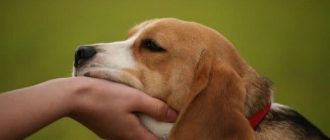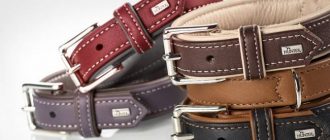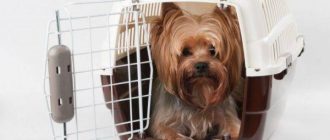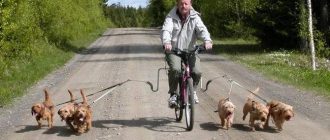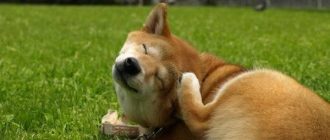Dog Hair Loss (or Alopecia) – Natural natural process when it comes to seasonal molting. But what to do, if the pet’s fur coat thins regardless of the season? IN in some cases, hair loss is a symptom of the disease. Find out the reasons why animal hair grows unpresentable appearance.
Hormonal disbalance
Contents
Very often, wool is strewed in animals due to violations hormonal plan. As a rule, with such ailments, hairless sections are symmetrical, and do not cover the whole body, but only some of its areas. To major hormonal diseases, due to которых сильно лезет шерсть у собаки, относят:
- Гипотиреоз – патология щитовидной железы. Subject to it overweight individuals and older dogs. Among dogs, sick hypothyroidism, the most common are dachshunds, cocker spaniels, retrievers, Dobermans, Irish setters, airedale. TO signs of hypothyroidism include hair loss and significant deterioration of all hair on the body, and hyperpigmentation of the skin, and slow heartbeat. They treat this problem with synthetic hormones. for the treatment of thyroid diseases (e.g. tablets Levothyroxine);
- Pituitary dwarfism (growth hormone deficiency) – a rare disease that is traditional for German shepherds. At similar ailments in dogs fall on the coat on the back and stomach. In addition, with a lack of growth hormone, dogs stop growing to 3-4 months, have problems with tooth growth, have thinned skin (often damaged by dermatitis), dandruff. Treatment involves the introduction of hormonal drugs;
- Cushing’s Syndrome (an excess of the hormone cortisol, responsible for opposing the body to stress) – with a similar disorder, the dog’s hair can fall out in any body parts. In addition, with Cushing’s syndrome, animals experience intense thirst, they often write, they behave inappropriately. Their skin has sore appearance, cracks. Animals with such a hormonal failure are few eat, actively lose weight, but their stomach looks bloated. Often such an illness occurs in dogs of the Dachshund and boxer breeds. For treatment drugs to suppress cortisol production are required (for example, Vetoril capsules);
- Hyperestrogenism (an overabundance of estrogen) is an ailment, which occurs in both bitches and males. Moreover, in animals in addition to hair loss on the sides and abdomen, there are also symptoms of hyperestrogenism: swelling of the vulva and nipples in females, testicular tumor (in males), coarsening of the skin, increased production sulfur. The treatment of the disease is solved by operable removal of organs. reproductions (ovaries or testes depending on gender);
- Hypoestrogenism (insufficient production of estrogen) – usually found in middle-aged bitches with problems gynecological plan. With hypoestrogenism, hair falls out in inguinal area (or just near the vulva), the skin becomes thin and soft. The disease is treated with the administration of the hormone estrogen.
When hormones have nothing to do with it
The dog’s coat is climbing heavily, often for reasons that can’t be not associated with hormonal disorders. Let’s try to consider главные причины потери волосяного покрова у собак: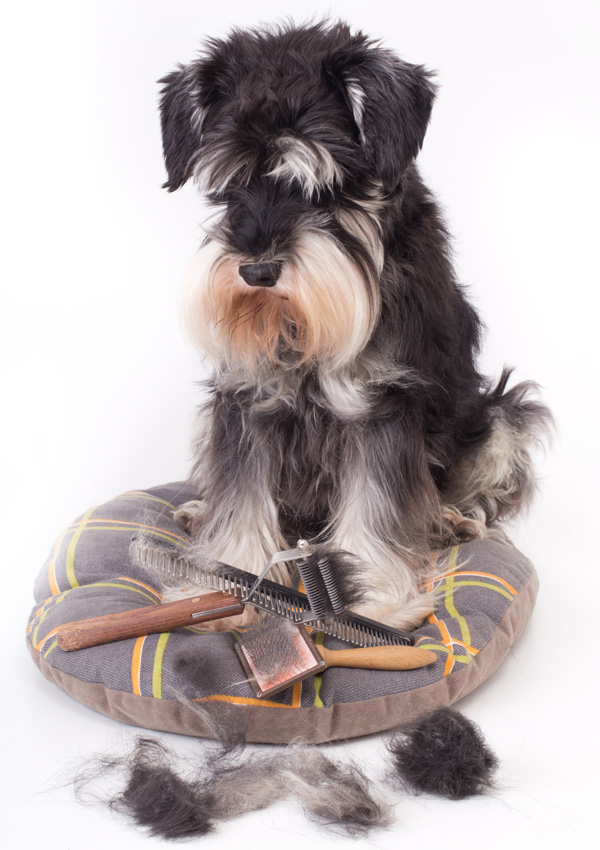
- Стресс – песики нередко переживают эмоциональныеbursts caused by a variety of reasons (for example, relocation, change or death of the owner, the appearance in the house of a new pet, etc.). Under stress, the dog not only balds, but also looks lethargic or, conversely, overexcited, she appears uncharacteristic habits (attempts to eat an inedible, frequent howl, cases of urination or bowel movements in the wrong places, aggression). Also, with stress, dogs eat little, refuse games. Sedatives are used as anti-stress therapy. and reasonable loads;
- Allergy (food and non-food) – a reaction to cosmetics, dust, food are some of the reasons why u dogs shred hair, rashes and itching appear body. With allergies, dogs often have problems with stools, they lacrimation is observed, on the skin from constant scratching occur sores. Treat allergies in animals by administering antihistamines, glucocorticosteroids, antibiotics (with infection), anti-inflammatory and wound healing ointments, but only after identifying the cause of the allergy;
- Parasitic diseases – if the animal is affected external or internal bloodsuckers, the condition of the coat is noticeable worsens. In the best case, the fur coat just looks dull, greasy. At worst, it thins. The appearance of an animal in which there are parasites, it has an unfavorable appearance: exhaustion, a dog gnaws hair on the hips, in the area near the tail, all skin it is covered with small ulcers from bites. With helminthic infestations dogs often have problems with the intestines and stomach (diarrhea, constipation, vomiting), feces and vomit may contain worms. Fleas, ticks and other bloodsuckers cause dogs to run wild desire to scratch, from this the whole body is covered with wounds (from claws and teeth). Ectoparasites also affect the peace of the dog, disrupting sleep, taking away the desire to play. Treatment of parasitic infestations primarily aimed at removing “uninvited guests” – fleas and helminths (or others);
- Fungal lesions – these diseases include trichophytosis, microsporia, ringworm. With these ailments in dogs the skin becomes inflamed and flaky, purulent wounds, hairs appear become thin and brittle, and sometimes the hair climbs to shreds. Puppies under the age of 1 year are especially susceptible to such ailments. Fungal infections are treated with antibacterial and symptomatic drugs, as well as vaccines against pathogens these diseases;
- Bacterial skin infections are among such ailments in dogs have pyoderma, dermatitis, subcutaneous abscesses. At such diseases, the skin becomes rough, reddened, visible on it papules, abscesses, the dog’s hair falls out in places. Therapy involves the introduction of antibiotics and symptomatic funds;
- Vitamin deficiency – and especially a lack of vitamins A, B2, B6, AT 12. With a lack of such organic compounds in dogs, bald spots appear on the neck, muzzle, limbs, worsens skin condition, itching appears, mucous membranes lighten, often lowered body temperature. Treat vitamin deficiencies specifically a selected diet, the introduction of vitamin preparations (for example, tablets “PolidexMultivitum”, “PervinalExel” or special vitamins for dogs against hair loss and against others adverse manifestations of vitamin deficiency “8 in 1 NutricoanScin&Coat”, “CaninaBiotinForte” или пр.);
- Adenitis of the sebaceous glands – skin inflammation that occurs more often in puppies and young doggies. With such problems in a dog hair falls out in places (usually in the ear area, on the head and back), the skin condition worsens (greasy plaque, peeling). Unwaxed hair looks fallen, greasy. Treat adenitis the use of corticosteroids, antiseptic shampoos, vitamin drugs;
- Black acanthosis is a skin disease caused by a violation the work of the sebaceous glands, in which hyperpigmentation of the skin is observed in the groin and armpits. The dermis itself with this disease often looks keratinized, rough, animals suffer from severe itching. On the affected areas usually fall out. Treatment involves the introduction of hormonal, anti-inflammatory, antihistamines drugs and vitamins;
- Ideopathic baldness in Greyhounds – cosmetic a defect that affects young growth of the specified breed. Wool falls only on the hips, and in rare cases in the abdomen. Skin with such an ailment does not suffer. The treatment is aimed at slowing down hair loss.
What to do if the dog has a lot of hair
So, given: the dog itches and hair falls out. How to be in such owner situation? Unfortunately, many hosts instead of going to at the veterinarian they prefer to go to a veterinary pharmacy at best, to buy a bunch of shampoos that improve the condition of the coat, balms, vitamins. It is not surprising that from self-treatment not only does not improve the condition of the coat, but и будет прогрессировать болезнь, которая вызвала алопецию. Если у животного лезет шерсть клочьями,it’s important to visit a specialist who will not only inspect the dog, but it will also take scrapings of the skin, urine and blood tests, conduct if necessary, hormonal research. Timely medical identification of the reasons for which there are problems with the coat dogs, allows you to start the correct and effective treatment. IN at home to find the necessary funds, unfortunately, do not will succeed.
Если у животного лезет шерсть клочьями,it’s important to visit a specialist who will not only inspect the dog, but it will also take scrapings of the skin, urine and blood tests, conduct if necessary, hormonal research. Timely medical identification of the reasons for which there are problems with the coat dogs, allows you to start the correct and effective treatment. IN at home to find the necessary funds, unfortunately, do not will succeed.

